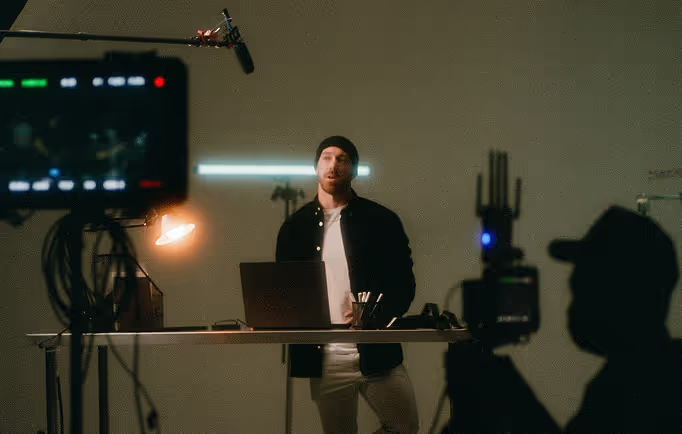Conveying Meaning In Every Scene Of Your Explainer Video

Making a fictional animated film is a fairly different art to making an explainer animation. While both have a high focus on keeping the audience engaged, one can focus more loosely on aesthetic and character development while the other must focus on the craft of, well, explaining stuff. Time is of the absolute essence in an explainer video, and each shot must convey information in a bite-sized way that’s easy to visually absorb. In other words, every scene must convey meaning.
It’s for this reason that explainer videos work so well in engaging viewers, and also it’s for this reason that making explainer videos is an art of its own accord (if we do say so ourselves). Here are some best practices for mastering the art form of conveying meaning in every scene:
1) clarify your end goal
Let’s not put the cart before the horse: before we can begin conveying meaning we need to be clear on what that meaning actually is. What is your end goal, and who are you really talking to? It’s absolutely vital to be clear in your own mind of the value you want to get across before you start your video campaign.
This is something that should be re-stated and re-evaluated at the start of any new campaign as it speaks to the image of both your brand in general, and to each individual piece of branded content. In a wider sense, this might involve your brand’s mission statement and company vision. In a focussed campaign it will look more closely at your specific target audience and their current and upcoming needs. Both goals should be working in tandem at all times, with the focussed campaign being a champion for your wider brand image.
2) use story beats to drive the video forward
Once you and your team are clear on the goal of your explainer video it’s time to work on how your script will be structured. To make sure each scene is driving your video forward it’s important to look at your story beats.
In traditional three act structure this would usually involve: 1 – Exposition (setting up the scene), 2 – Conflict (the major complication the protagonist has to overcome), and 3 – Resolution (whether good, bad, or ambiguous). In terms of explainer videos we often see an abbreviated version of this: the Problem-Solution format. Both the exposition and conflict are laid out within the first two sentences, and often within the first 10 seconds of the video: “This is [character], they want [goal] but can’t get it because [obstacle]. The secret weapon that leads to [character]’s resolution? Introducing [product]!”
Sound familiar? There’s a reason the Problem-Solution format is so pervasive amongst the explainer video genre: because at all times it focuses very clearly on the value to the viewer. Instead of getting caught up in a technical video of the inner workings of [product], we are now focussed on the much more interesting narrative of why we should care. How will this resolve the initial problem for [character] and therefore the viewer? (If your name happens to be ‘[character]’ then you’re even more set. Also, your parents have a lot to answer for.) This format makes it easy to convey meaning in every scene because we are now driving the story forward with a very specific problem solving trajectory.
3) keep the message, and your words, brief
Part of truly delivering meaning in every scene is learning not to get derailed by unimportant detail. How unimportant is unimportant, you ask? When it comes to one- to two-minute explainer videos, the bar is high. Each scene not only needs to be focussed on the direct problem-solution format of the topic in question, but needs to be conveyed with brevity and simplicity.
By keeping the message brief we’re pushed to funnel down to only the most compelling selling points. At the heart of it all, why should the audience give you a minute of their time? What value does your explainer video have to offer?
Secondly, by using plain language we set ourselves up to access the widest audience possible. This doesn’t necessarily mean avoiding technical jargon: if your target viewer is industry professionals who are likely to understand the field there’s no harm in directly addressing your technical terms. Rather, what we mean by plain language is being direct and unambiguous. An explainer video is not the time for linguistic tricks, riddles, and mind games that require the audience to guess what your message is. Using easily understandable sentences (and visual language) is highly important for the viewer’s mental recall of the content.
4) use every part of the visuals to drive home your message
Think further than your script. When you’re working with an animated explainer video every part of the visual language can be crafted to emphasise your point. The basic elements and principles of design can and should be selected for maximum interest, understanding, and emotional impact in line with your chosen message. Think colour schemes, thick or thin line styles, shape meanings, camera direction, brightness, visual unity, contrast, and harmony. Does your colour scheme do more than copy the palette of the company logo? Do the shapes in your video indicate stability, comfort, or dynamism? Are you using design elements that are unified to promote a sense of community, or contrast to promote empowerment for the individual?
The possibilities can be a bit overwhelming, especially if you’re not involved with the design or production fields. If you’re working with a solid video production company, the good news is they’ll be able to guide you through the ins and outs of how they’re making the most of the visual design to push your message forward. And if you have yet to reach out to a video production crew, the good news is there’s no better time than right now to get in touch.
Start a






